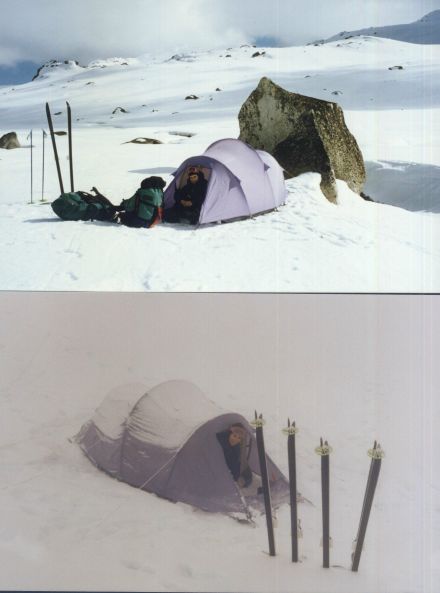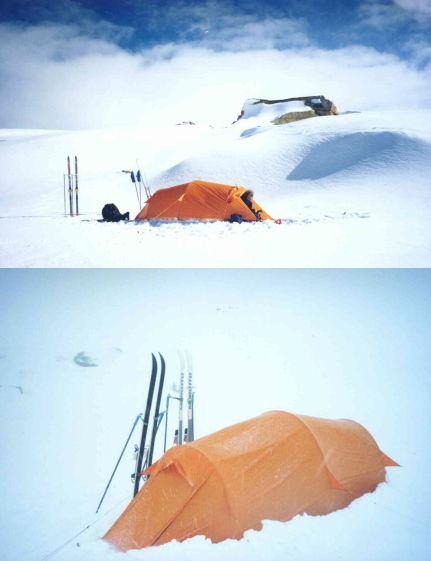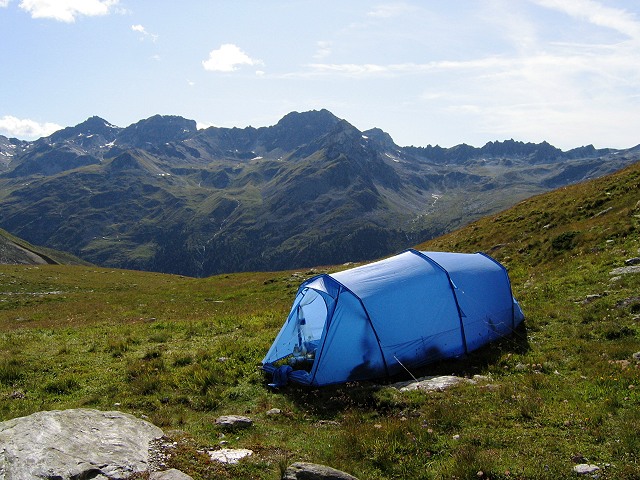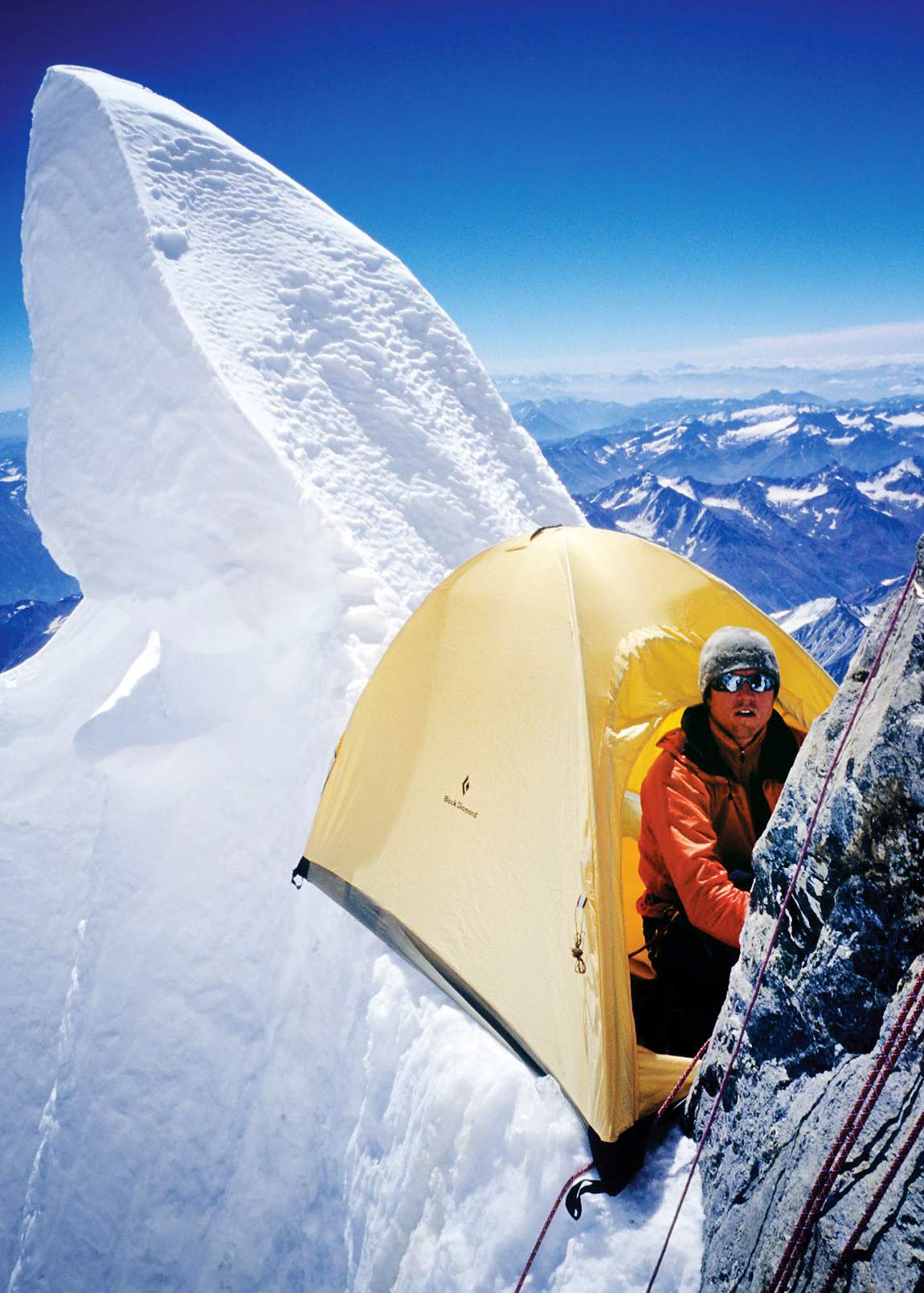Topic
Single skin mountain tents
Forum Posting
A Membership is required to post in the forums. Login or become a member to post in the member forums!
Home › Forums › Gear Forums › Gear (General) › Single skin mountain tents
- This topic has 29 replies, 12 voices, and was last updated 8 years, 10 months ago by
 Sam Farrington.
Sam Farrington.
-
AuthorPosts
-
Apr 18, 2016 at 3:45 pm #3396689
I am interested in single skin tents for high altitude mountaineering.
Some single skins are pretty waterproof but breathe poorly, some are merely windproof but breathe better. All suffer from condensation to varying degrees. However, some single skins have an inner surface which absorbs moisture preventing it from dripping down your face. If the temperature and outside humidity is in favor, the moisture will be conveyed to the outside by whatever mechanism the actual fabric supports. If not, it will stay on the inside, but not drip (so much).
ToddTex is a well known fabric, which does exactly this – it is fuzzy on the inside, and it breathes. Now, the British tent maker Crux use a fabric, X-tex, which has activated carbon on the inside which should manage moisture in a similar way.
If anyone here has experience with these kind of tents, maybe they will be able to answer a few questions:
1) How waterproof is X-tex?
2) How well does it breathe?
3) How well does it manage moisture, preventing from dripping?Thanks
Apr 18, 2016 at 5:11 pm #3396707I have little faith, but I am interested.
Cheers
Apr 18, 2016 at 6:28 pm #3396722When you google up Mt Everest tents you see mostly double wall tents. I wonder why this is??
Apr 18, 2016 at 6:44 pm #3396723“I wonder why this is??”
You mean the base camp tents? Yeah – exactly the same thing.
Apr 18, 2016 at 6:51 pm #3396726“I wonder why this is??”
Function, comfort, common sense … and a desire to stay dry inside?
Cheers
Apr 18, 2016 at 7:01 pm #3396729Roger, do you mountaineer? If so, which peaks?
Apr 18, 2016 at 7:18 pm #3396731Not familiar with X-tex, wonder if anyone on here is, but I certainly have experience with Bibler designs, before and after the BD merger. Mine have only leaked when nearing the end of their lifecycle, but condensation is an issue I never found a way to eliminate.
To make it short, their main assets for me is the ease of setting up and super small footprint. Finding a tent platform on steep climbs is challenging. The smaller the tent the better. And really only single wall, floored, non-vestibuled mini shelters like this works.
If vertical terrain is not on the program, but the chance of ferocious storms is, I far prefer the slightly roomier comfort of a well ventilated double wall tent. Like my Hilleberg.
Apr 18, 2016 at 7:38 pm #3396737“Roger, do you mountaineer? If so, which peaks?”
Please read “The Ascent of Rum Doodle” …
I have been as high as about 5,755 m, via Taschi Lapcha in Nepal. It was OK, but we slept lower. That expedition was run by a commercial company, who did a rather poor job of it. Some of the porters went on strike.
Trips over the European Alps have been far more common: Pyrenees and the main Alps in France, Switzerland, Austria etc. By and large, that took us up to 3,000 m, and we were often camping, just the two of us for all of those.
In Australia we go XC ski touring in winter, up to 2,200 m, with camping. Purple tent: Macpac Olympus; orange tent: my V1 MYOG winter tent. In each case the weather changed overnight, but that is dead normal for Oz.
Cheers

 Apr 18, 2016 at 7:51 pm #3396740
Apr 18, 2016 at 7:51 pm #3396740Stefan,
have you looked at the eVent tents still around ?
The RAB Summit Extreme or the Exped Polaris if you need something a bit larger.If I were you I would contact Carol at Crux, he helped me in the past and I am pretty sure he knows his stuff..
Apr 18, 2016 at 8:58 pm #3396747Thanks Roger – I wonder why we don’t see more three pole tunnels in NA.
Apr 18, 2016 at 10:00 pm #3396753David L—Here are pics of tents at 26,000 feet in the South Col of Mt Everest—and not exactly base camp tents—these tents where hand carried to this location—and most of them are double wall—
Apr 18, 2016 at 10:17 pm #3396754I wonder why we don’t see more three pole tunnels in NA.
Several reasons, and they may seem to be a circular argument.
Most NA walkers only travel in the 3 seasons in forested lands, maybe even less than that, and don’t need a real alpine tent.
Most mfrs are focused solely on the biggest market they can see – which is the limited 3-season walker and the ‘Sierra Summers’.
Most tents are made in China anyhow, and the Chinese factories do not know how to make tunnel tents (I TRIED, and failed).
Tunnel tents are inherently more expensive than pop-ups, so they are less popular to the mass market.
Retailers only want simple mass-market stuff as well, to avoid too many returns from newbies who ‘broke it’.
Anyhow, while 3-pole tunnels are fairly good, it’s the 4-pole tunnels which will really take a hammering. It’s all about unsupported fabric span.

Cheers
 Apr 18, 2016 at 10:22 pm #3396755
Apr 18, 2016 at 10:22 pm #3396755Tipi, horses for courses ..
(I think I’ve mentioned this before…)
Generally speaking expeditions will use multipole geodesic tents in the 8-12lbs range.
That is because they have porters, many .Guys (and girls) that do the Alpine style climbing,( one to three guys carrying everything themselves, up and down as fast as practical), generally don’t carry 10 pound tents.
Apr 19, 2016 at 3:30 am #3396766From Crux:
X-tex fabric has a woven textile face with a coating to make it
both waterproof and breathable.
X-tex fabric has a 50 denier polyester face. 50 denier is a heavy
yarn by today’s standards, but we consider it important for a
mountaineering tent, since the intrinsic strength of a fabric is
derived primarily from the thickness of the yarn. Unusually, we
have chosen polyester rather than nylon, as polyester offers
superior resistance to UV degradation. Bivouac tents tend to
find themselves pitched at higher altitudes where UV levels are
also significantly greater.
X-tex fabric is coated with polyurethane (PU), which serves as
a substrate for the activated carbon which gives X-tex its
unique properties. PU has a monolithic (i.e. non-porous)
structure, which means it has an outstanding water column for
water resistance (20,000+ mm, or 30+ psi). The coating
‘breathes’ by transporting the water molecules through
hydrophilic attraction, a mechanism used by a large number of
branded fabrics employed in waterproof/breathable garments.
However, a PU coating on its own is insufficient to deal with the
condensation experienced in single-wall tents, as the moisture
build-up overloads the fabric’s ability to absorb it. To manage
this, the PU coating is impregnated with activated carbon,
greatly increasing the surface area available to absorb water
molecules. These consequently stay in the disassociated state
(i.e. they don’t form droplets) and continue to diffuse through
the coating (i.e. the fabric continues to breathe), while the
fabric itself remains dry to the touch.
Fabric weight: 132 g/m² (3.9 oz/yd²)
Hydrostatic head: 20,000 mm water column (30 psi)
MVTR: 25,000 g/m²/24 hrs (JIS-II)
Repellency: 80 (new) / 20 (after 20 washes) (AATCC)Then, about moutaineering, Usually, it’s not about simple walking, but about actual climbing like stuff. E.g. in the European Alps, up to 3000 or 3500 m is the domain of walkers; above it you need climbing skills so you’re in the domain of mountaineers. (This is a generalisation as there are lower peaks than 3000m for which you need climbing skills).
Apr 19, 2016 at 8:28 am #3396786Tipi Walter, I’m not interested in mass tourism like that on Everest, and I haven’t got the money either. But that is another story. Alpine style climbing sometimes involve a bivouac during summit push, and sometimes it is hard to find a level platform:
 Apr 19, 2016 at 8:42 am #3396788
Apr 19, 2016 at 8:42 am #3396788Franco Darioli,
Yes, I have heard about eVent and RAB tents and several other on the market. It is just that X-tex is new to me, and I wanted to know more on this specific fabric. Still, I’m open to hear about your experience with eVent tents.
Good idea to contact Carol, even though he will be biased when comparing to other fabrics.
Apr 19, 2016 at 8:49 am #3396789Woubeir,
Thanks for the details from the Crux website. Strange, I can’t find it myself. There are some technical specifications, but not all the text you quote. Would you be so kind as to submit a link?
Apr 19, 2016 at 8:59 am #3396793It’s from the workbook and there’s no direct online source I’m afraid.
Apr 19, 2016 at 9:00 am #3396794Roger Caffin,
I have nothing against tunnel (or geodesic tents), but they are not the best for the intended purpose: Summit push bivouac’s.
Apr 19, 2016 at 9:04 am #3396796Good grief people; if you don’t have anything relevant to say, be quiet!
The “activated carbon” bit sounds similar/identical to cocona/37.5, which has been around for a while and is not a gimmick. Whether it would reduce the condensation drip factor like Todd Tex does is a separate question.
It’d be fantastic if someone made a BD Eldorado, but lighter, without giving up any function. Anyone who doubts the capability of that tent hasn’t used it.
Apr 19, 2016 at 9:08 am #3396799George H,
What BD/Bibler have you had? They have used two or three types of fabric, ToddTex being best at managing moisture.
And, what Hilleberg do you prefer for flat terrain?
Apr 19, 2016 at 9:21 am #3396804David Chenault,
You may be right that 37.5 and X-tex are similar or even the same – Crux is among the brand partners of 37.5: https://www.thirtysevenfive.com/partners/brand-partners
Apr 19, 2016 at 9:53 am #3396812Great thread Stefan as i have been looking at the Crux tents e-tex vs Rab event.Being able to set up the Crux tent with the poles on the outside is very appealing.But getting some user performance reviews is sparse.
Apr 19, 2016 at 10:47 am #3396820I have some 250+ nights in BD’s various single skin offerings from the Bibler Toddex to the Shasta epic (yellow) to the current proprietary fabric (wasabi green).
In BIbler Toddex, I had a Fitzroy and an Eldorado (two door) that worked very well in terms of moisture management. Both tents were incredibly strong and easy to set up in mixed conditions. Frost would form on the inside but the fuzzy facing kept it on the wall surprisingly well even when the sun would thaw things and melt the frost allowing it to evaporate. My biggest complaint wasn’t even the weight but the bulk. The Eldorado was mostly carried on my back but the Fitzroy was typically in a sled where it didn’t matter as much. These were both used at altitude in extreme winter conditions with great success. I especially appreciated the ability to stake it out and then climb inside out of the weather to erect the tent. The Fitzroy was bomber and I slept through many nights while the wind and snow raged all night.
The BD tents were a Skylight and a pair of First Lights. The Skylight was the yellow version and the Firstlight was one early version and a later green version. I still have the Wasabi Firstlight and use it primarily in dry winter conditions. The Skylight was used mostly in shoulder seasons in exposed terrain above tree line and performed well. Most nights were in the worse conditions for a single wall with snow and freezing rain alternating. Condensation was at times manageable but somewhat problematic, with dripping off the poles in particular. For the weight and compact size, I was always impressed with the wind shedding capabilities and even in extended rain (24-36 hours of non stop), I never had problems that were a concern in terms of the tent’s ability to protect me from the elements. I use the Firstlight solo and the Skylight double. I have found for me that if the tent is large enough to avoid the walls when condensation is present, it isn’t an issue. Two people in a Firstlight wouldn’t work for me.
Neither of the BD tents have been above 13,500 feet but they have experienced high winds – 40-50 mph sustained with gusts to 60 or more. No damage but I have had to sit leaning against the wall to keep the tent from collapsing for hours. The Skylight handled wind better than the Firstlight but would be a poor choice for high altitude with all the mesh obviously, but the fabric performed well. I know others had issues they could or didn’t expect to have to deal with, but overall well executed single wall designs.
Apr 19, 2016 at 11:27 am #3396827Activated carbon? Cool. I’d love to hear more about that, too. Regarding Event, it seems to me to be a good wpb fabric, but I don’t see it as a complete vapor/moisture management system since it doesn’t manage condensed vapor. (Like Todd/Tegral Tex)
While I don’t pull out my Eldorado as often as I did 20 yrs ago, it still amazes me how well it deals with condensing vapor. It’s important to remember that at certain temperatures, vapor will condense no matter what, and how a fabric deals with it at that particular point is crucial. Of course one can’t beat a well designed double walled system, but it’s obviously not always practical.
But it sure sounds like the activated carbon might do the same thing as Toddtex, but personally I’d want to know a lot more about it’s °/RH/hPa “comfort zone”, overall performance, and long term durability before I’d drop a $$ into it. I’m replacing carbon water filter cartridges in my refrigerator all the time, so how long will the PU substrate keep the carbon suspended, or will it fall apart or “clog up” at some point?
At least ToddTex still does it’s thing.
-
AuthorPosts
- You must be logged in to reply to this topic.
Forum Posting
A Membership is required to post in the forums. Login or become a member to post in the member forums!
Trail Days Online! 2025 is this week:
Thursday, February 27 through Saturday, March 1 - Registration is Free.
Our Community Posts are Moderated
Backpacking Light community posts are moderated and here to foster helpful and positive discussions about lightweight backpacking. Please be mindful of our values and boundaries and review our Community Guidelines prior to posting.
Get the Newsletter
Gear Research & Discovery Tools
- Browse our curated Gear Shop
- See the latest Gear Deals and Sales
- Our Recommendations
- Search for Gear on Sale with the Gear Finder
- Used Gear Swap
- Member Gear Reviews and BPL Gear Review Articles
- Browse by Gear Type or Brand.








